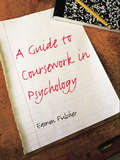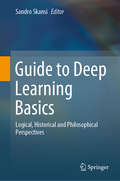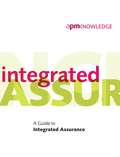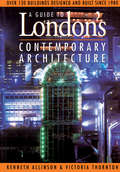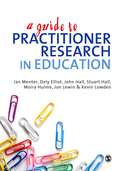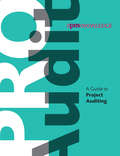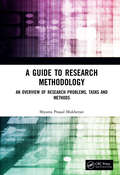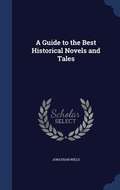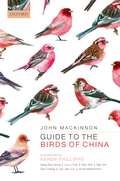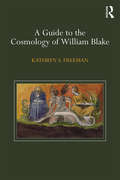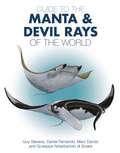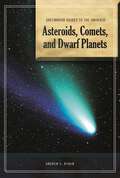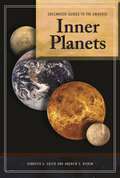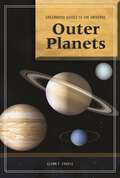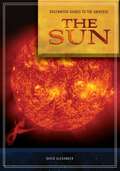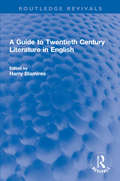- Table View
- List View
A Guide to Coursework in Psychology
by Eamon FulcherEver had difficulty choosing a research project? Ever wondered how your work will be marked? This book will help students to understand the coursework specifications and marking criteria for a number of key exam boards, including; AQA (specification A and B), OCR, EDEXCEL and SQA. It provides specific and highly relevant advice on how to maximise achievement in coursework. Guidance is offered on how best to choose a research project, through to practical advice on how to carry out research and write up reports. Topics to be avoided are also considered and advice on how to navigate the difficulties and avoid common pitfalls provided. Key issues covered include: * An overview of the main methods of investigation in psychology * Data analysis, including how to present data in Word and Excel and how best to comment on it * How to draw conclusions from data and create inferential statistics. Incorporating a series of examples, including an investigation from start to finish, and a laboratory experiment, this book provides clear, hands-on advice. It will be an invaluable tool for GCSE, AS and A2 students, helping them to maintain their motivation through coursework assignments and to achieve their potential.
Guide to Deep Learning Basics: Logical, Historical and Philosophical Perspectives
by Sandro SkansiThis stimulating text/reference presents a philosophical exploration of the conceptual foundations of deep learning, presenting enlightening perspectives that encompass such diverse disciplines as computer science, mathematics, logic, psychology, and cognitive science. The text also highlights select topics from the fascinating history of this exciting field, including the pioneering work of Rudolf Carnap, Warren McCulloch, Walter Pitts, Bulcsú László, and Geoffrey Hinton.Topics and features:Provides a brief history of mathematical logic, and discusses the critical role of philosophy, psychology, and neuroscience in the history of AIPresents a philosophical case for the use of fuzzy logic approaches in AIInvestigates the similarities and differences between the Word2vec word embedding algorithm, and the ideas of Wittgenstein and Firth on linguisticsExamines how developments in machine learning provide insights into the philosophical challenge of justifying inductive inferencesDebates, with reference to philosophical anthropology, whether an advanced general artificial intelligence might be considered as a living beingInvestigates the issue of computational complexity through deep-learning strategies for understanding AI-complete problems and developing strong AIExplores philosophical questions at the intersection of AI and transhumanismThis inspirational volume will rekindle a passion for deep learning in those already experienced in coding and studying this discipline, and provide a philosophical big-picture perspective for those new to the field.
A Guide to Integrated Assurance
by APM Assurance Specific Interest GroupA Guide to Integrated Assurance enables organisations to improve the efficiency and effectiveness of their assurance activities. Written by APM’s Assurance Specific Interest Group, the guide identifies important roles and responsibilities as well as tools and templates to help overcome ‘silo-oriented approaches’ to assurance that do not naturally result in integration. It is aimed at project managers, sponsors (in particular, those responsible for designing and carrying out assurance activities) and stakeholders with an interest in the successful delivery of the projects, programmes or portfolios. Readers of this publication may also be interested in APM Introduction to Programme Management 2nd edition and Directing Change.
A Guide to Interviewing Children: Essential Skills for Counsellors, Police Lawyers and Social Workers
by Claire Wilson Martine PowellChildren may be witnesses to crimes or accidents, or suspected victims of abuse or neglect, or they may be involved in some form of legal action such as custody cases. In these situations, they may need to be interviewed formally, and if this is not done properly, incorrect or inadequate information may be recorded or the child's position may not be correctly represented later in court. In cases of child abuse, the child may not be the only witness, and the quality of their verbal evidence is critical.A Guide to Interviewing Children is a practical guide the evidential interviewing techniques needed by a range of professionals: social workers, forensic psychologists, lawyers, police and teachers. It outlines basic techniques, explains how to deal with children of different ages (from pre-school to fifteen years), how to deal with parents, the particular issues of sexual abuse, handling multiple interviews of one child and so on. It is written for an international readership, and will be more practical and cover a broader range of contexts than the other titles currently available.
A Guide to Interviewing Children: Essential Skills for Counsellors, Police Lawyers and Social Workers
by Claire Wilson Martine PowellChildren may be witnesses to crimes or accidents, or suspected victims of abuse or neglect, or they may be involved in some form of legal action such as custody cases. In these situations, they may need to be interviewed formally, and if this is not done properly, incorrect or inadequate information may be recorded or the child's position may not be correctly represented later in court. In cases of child abuse, the child may not be the only witness, and the quality of their verbal evidence is critical.A Guide to Interviewing Children is a practical guide the evidential interviewing techniques needed by a range of professionals: social workers, forensic psychologists, lawyers, police and teachers. It outlines basic techniques, explains how to deal with children of different ages (from pre-school to fifteen years), how to deal with parents, the particular issues of sexual abuse, handling multiple interviews of one child and so on. It is written for an international readership, and will be more practical and cover a broader range of contexts than the other titles currently available.
Guide to Life and Literature of the Southwest
by Frank DobieA compilation of South-Western literature.
Guide to London's Contemporary Architecture
by Victoria Thornton Kenneth AllinsonGuide to London's Contemporary Architecture provides a guide to the wealth of architecture completed in London. The book first offers information on the buildings located in the City of London and the Docklands. These include the Broadgate Complex, Alban Gate, Bracken House, Whitechapel Art Gallery, Queen Street offices, Girozentrale Vienna, Minster Court, Billingsgate Securities Market, Canary Wharf, Financial Times Printing Works, Isle of Dogs Neighborhood Center, Reuters Technical Services Centre, and the David Mellor building. The publication examines the structures found in the East End, West End, and north London. Discussions focus on Sainsbury Wing, National Gallery, Sackler Gallery, Queen Elizabeth II Conference Center, Richmond House, Clore Gallery, Lauriston Studios, Leyton Fire Station, Lisson/Bell Street galleries, Lisson Grove offices and flats, Sainsbury supermarket and housing, Crowndale Centre, Nightingale house, and the Bisterne Avenue apartments. The text takes a look at the edifices located in west London, including Richmond Riverside, Sterling Hilton Hotel, Thames Wharf Studios, St Mary's Church, Barnes, Metropolis Studios, and the Fowler/Jestico house.The publication is a dependable reference for architects and design engineers interested in the architecture of London.
Guide to Methods for Students of Political Science
by Stephen van Van Evera"Stephen Van Evera's Guide to Methods makes an important contribution toward improving the use of case studies for theory development and testing in the social sciences. His trenchant and concise views on issues ranging from epistemology to specific research techniques manage to convey not only the methods but the ethos of research. This book is essential reading for social science students at all levels who aspire to conduct rigorous research."—Alexander L. George, Stanford University, and Andrew Bennett, Georgetown University"Van Evera has a keen awareness of the questions that arise in every phase of the political science research project—from initial conception to final presentation. Although others may not agree with all of his specific advice, all will appreciate his user-friendly introduction to what is sometimes seen as an abstract and difficult topic."—Timothy J. McKeown, University of North Carolina, Chapel HillFor the last few years, Stephen Van Evera has greeted new graduate students at MIT with a commonsense introduction to qualitative methods in the social sciences. His helpful hints, always warmly received, grew from a handful of memos to an underground classic primer. That primer has now evolved into a book of how-to information about graduate study, which is essential reading for graduate students and undergraduates in political science, sociology, anthropology, economics, and history—and for their advisers.
A Guide to Practitioner Research in Education
by Dr Dely Elliot Jon Lewin Kevin Lowden Moira Hulme Prof Ian J MenterThis book is a guide to research methods for practitioner research. Written in friendly and accessible language, it includes numerous practical examples based on the authors' own experiences in the field, to support readers. The authors provide information and guidance on developing research skills such as gathering and analysing information and data, reporting findings and research design. They offer critical perspectives to help users reflect on research approaches and to scrutinise key issues in devising research questions. This book is for undergraduate and postgraduate students, teachers and practitioners in practitioner research development and leadership programmes. The team of authors are all within the School of Education at the University of Glasgow and have significant experience of working with practitioner researchers in education.
A Guide to Practitioner Research in Education (PDF)
by Moira Hulme Jon Lewin Kevin Lowden Dr Dely Elliot Prof Ian J MenterThis book is a guide to research methods for practitioner research. Written in friendly and accessible language, it includes numerous practical examples based on the authors' own experiences in the field, to support readers. The authors provide information and guidance on developing research skills such as gathering and analysing information and data, reporting findings and research design. They offer critical perspectives to help users reflect on research approaches and to scrutinise key issues in devising research questions. This book is for undergraduate and postgraduate students, teachers and practitioners in practitioner research development and leadership programmes. The team of authors are all within the School of Education at the University of Glasgow and have significant experience of working with practitioner researchers in education.
A Guide to Project Auditing
by Apm Assurance SigWhat is an audit, why do we undertake project audits and how does it differ from other assurance methods? The answer to these and other related questions can be found in the latest APM publication, A Guide to Project Auditing. Written by the APM’s Assurance SIG, the guide explains the role of an audit, how it can be planned and undertaken, and the degrees of assurance that can be given. To help readers, A Guide to Project Auditing includes a number of resources (12 charts and tables) designed to help perform an audit review of a project, and identify the associated risks and control measures. The guide authors say: “This guide is principally intended for use by project auditors in developing an audit approach to the review and assurance of projects… it is also intended to be of value to anyone involved in the management and administration of projects.” Readers may also be interested in A Guide to Integrated Assurance and Directing Change – A Guide to Governance of Project Management.
A Guide to Research Methodology: An Overview of Research Problems, Tasks and Methods
by Shyama Prasad MukherjeeResearch Methodology is meant to provide a broad guideline to facilitate and steer the whole of a research activity in any discipline. With the ambit and amount of research increasing by the day, the need for Research Methodology is being widely appreciated. Against this backdrop, we notice the dearth of well-written books on the subject. A Guide to Research Methodology attempts a balance between the generic approach to research in any domain and the wide array of research methods which are to be used in carrying out different tasks in any research. Discussions on these research methods appropriate in various disciplines have focused on the research tasks, keeping in mind the fact that a single such task like a comparison among alternatives may involve several methods from seemingly distinct areas. Unique features of this volume, as will be evident to a discerning reader, include: A detailed discussion on problem areas for research in several domains An illustrative and ampliated list of research problems drawn from different disciplines which can be pursued by interested research workers A comprehensive delineation of Research Design supported by illustrations An elaborate engagement with models with a note on model uncertainty Focus on recent and emerging models, methods and techniques A novel treatment of data analysis where the nature of data and the objective(s) of analysis justify drawing upon a variety of techniques for analysis This book will serve the purpose of a pre-PhD or a Master-level course-work for students of any discipline with a basic knowledge of quantitative analysis. In fact, anyone aspiring to take up meaningful research work will find the content useful and interesting.
A Guide to Research Methodology: An Overview of Research Problems, Tasks and Methods
by Shyama Prasad MukherjeeResearch Methodology is meant to provide a broad guideline to facilitate and steer the whole of a research activity in any discipline. With the ambit and amount of research increasing by the day, the need for Research Methodology is being widely appreciated. Against this backdrop, we notice the dearth of well-written books on the subject. A Guide to Research Methodology attempts a balance between the generic approach to research in any domain and the wide array of research methods which are to be used in carrying out different tasks in any research. Discussions on these research methods appropriate in various disciplines have focused on the research tasks, keeping in mind the fact that a single such task like a comparison among alternatives may involve several methods from seemingly distinct areas. Unique features of this volume, as will be evident to a discerning reader, include: A detailed discussion on problem areas for research in several domains An illustrative and ampliated list of research problems drawn from different disciplines which can be pursued by interested research workers A comprehensive delineation of Research Design supported by illustrations An elaborate engagement with models with a note on model uncertainty Focus on recent and emerging models, methods and techniques A novel treatment of data analysis where the nature of data and the objective(s) of analysis justify drawing upon a variety of techniques for analysis This book will serve the purpose of a pre-PhD or a Master-level course-work for students of any discipline with a basic knowledge of quantitative analysis. In fact, anyone aspiring to take up meaningful research work will find the content useful and interesting.
Guide to the Birds of China
by John MacKinnonChina covers about 7% of the earth's land surface and encompasses a hugely diverse range of habitats. As a result, it boasts a rich and diverse avifauna, including some of the most spectacular and fascinating birds to be found anywhere in the world. Building on the enormous popularity and reputation of the original A Field Guide to the Birds of China (2000), John MacKinnon's fully updated and refreshed work remains a truly comprehensive, taxonomically modern, fully illustrated, and authoritative field guide. 1484 bird species are richly illustrated in 164 annotated colour plates, which are closely integrated with up-to-date colour distribution maps, QR codes providing easy access to birdcalls, IUCN Red List status indicators and new, concise descriptions. These descriptions feature key observations as well as conveying crucial changes to species distributions resulting from climate change and landscape transformation. Guide to the Birds of China will appeal to an international and growing audience of professional and amateur ornithologists and birding enthusiasts, academic researchers and students, wildlife photographers, and conservationists.
A Guide to the Cosmology of William Blake
by Kathryn S. FreemanIt is not surprising that visitors to Blake’s cosmology – the most elaborate in the history of British text and design – often demand a map in the form of a reference book. The entries in this volume benefit from the wide range of historical information made available in recent decades regarding the relationship between Blake’s text and design and his biographical, political, social, and religious contexts. Of particular importance, the entries take account of the re-interpretations of Blake with respect to race, gender, and empire in scholarship influenced by the groundbreaking theories that have arisen since the first half of the twentieth century. The intricate fluidity of Blake’s anti-Newtonian universe eludes the fixity of definitions and schema. Central to this guide to Blake's work and ideas is Kathryn S. Freeman's acknowledgment of the paradox of providing orientation in Blake’s universe without disrupting its inherent disorientation of the traditions whereby readers still come to it. In this innovative work, Freeman aligns herself with Blake’s demand that we play an active role in challenging our own readerly habits of passivity as we experience his created and corporeal worlds.
A Guide to the Cosmology of William Blake
by Kathryn S. FreemanIt is not surprising that visitors to Blake’s cosmology – the most elaborate in the history of British text and design – often demand a map in the form of a reference book. The entries in this volume benefit from the wide range of historical information made available in recent decades regarding the relationship between Blake’s text and design and his biographical, political, social, and religious contexts. Of particular importance, the entries take account of the re-interpretations of Blake with respect to race, gender, and empire in scholarship influenced by the groundbreaking theories that have arisen since the first half of the twentieth century. The intricate fluidity of Blake’s anti-Newtonian universe eludes the fixity of definitions and schema. Central to this guide to Blake's work and ideas is Kathryn S. Freeman's acknowledgment of the paradox of providing orientation in Blake’s universe without disrupting its inherent disorientation of the traditions whereby readers still come to it. In this innovative work, Freeman aligns herself with Blake’s demand that we play an active role in challenging our own readerly habits of passivity as we experience his created and corporeal worlds.
Guide to the Manta and Devil Rays of the World (Wild Nature Press)
by Dr. Guy Stevens Dr. Daniel Fernando Marc Dando Dr. Giuseppe Notarbartolo Di SciaraManta and devil rays are some of the most intriguing creatures in the ocean. Driven forward by powerful beats of wing-like pectoral fins, these filter feeders search the waters for prey, their horn-like head fins giving rise to ancient mariners’ tales of fearsome devilfish dragging boats into the ocean depths. Beloved by scuba divers and marine biologists alike, these impressive animals have never had a comprehensive field guide dedicated to them—until now.Guide to the Manta and Devil Rays of the World includes detailed information on the identification, characteristics, threats, and distribution for each species in this family. Illustrated with more than 200 color photos, drawings, and plates, this guide also contains an expansive introduction to the general taxonomy, biology, and behavior of these iconic animals. This book will be an essential resource for fisheries management and international trade enforcement, and for anyone involved in ongoing manta and devil ray research and conservation. The first dedicated field guide for manta and devil raysExhaustive treatment of every aspect related to their identification and biologyFilled with 200+ color drawings, photos, and diagrams
Guide to the Universe: Asteroids, Comets, and Dwarf Planets (Greenwood Guides to the Universe)
by Andrew S. RivkinGeared toward students, this guide provides an overview of the small bodies that orbit the sun.This volume in the Greenwood Guides to the Universe series covers asteroids, comets, and dwarf planets—those small bodies that revolve the Sun—and provides readers with the most up-to-date understanding of the current state of scientific knowledge about them. Scientifically sound, but written with the student in mind, Asteroids, Comets, and Dwarf Planets is an excellent first step for researching the exciting scientific discoveries of the smallest celestial bodies in the solar system.The book will introduce students to all of the areas of research surrounding the subject, answering many intriguing questions. It defines a dwarf planet and explains why Pluto is one. It looks at how such small bodies form, what they are made of, and what kind of atmospheres might they have. And it asks—and answers—whether asteroids, comets, and dwarf planets present a hazard to the Earth or to spacecraft.
Guide to the Universe: Inner Planets (Greenwood Guides to the Universe)
by Jennifer A. Ph.D. Andrew S. RivkinAn expert in planetary sciences offers an accessible synopsis of scientific knowledge about the celestial bodies with which we are most familiar—Mercury, Venus, Earth, and Mars.This volume in the Greenwood Guides to the Universe series covers the inner planets—Mercury, Venus, Earth, and Mars. Thematic chapters discuss all of the many areas of astronomical research surrounding each subject, providing readers with the most up-to-date understanding of current knowledge and the ways in which it has been obtained.Like all of the books in this series, Inner Planets is scientifically sound, but written with the student in mind. It is an excellent first step for researching the exciting scientific discoveries of the Earth and its closest neighbors.
Guide to the Universe: Outer Planets (Greenwood Guides to the Universe)
by Glenn F. ChapleA long-time avid amateur astronomer living in Massachusetts, Chaple profiles the Jovian planets, that is the gas giants and their many moons, but not the former planet Pluto. His topics include the birth of the Jovian planets, Jupiter's moons as a solar system in miniature, Saturn as the crown jewel of the Solar System (the full sized one), the tipped-over worldUranus, Neptune the planet discovered on paper, Jovian planets beyond our solar system, and Voyager 2's grand tour.
Guide to the Universe: The Sun (Greenwood Guides to the Universe)
by David AlexanderOur knowledge of the universe has increased tremendously over the last century, and our discoveries are not over - there remain scientific mysteries that the next generation of astronomers and planetary scientists will need to solve. This volume in the Greenwood Guides to the Universe series covers the Sun, and provides readers with the most up-to-date understanding of the current state of scientific knowledge. Scientifically sound, but written with the student in mind, The Sun is an excellent first step for researching the exciting scientific discoveries of the star at the center of our solar system.The Sun discusses all areas of research surrounding the subject, including: Sunspots and the solar surface; the many faces of the solar atmosphere; the solar wind and solar storms; and the long-term climate effects on the earth's atmosphere. The volume includes a glossary and a bibliography of useful resources for learning more about the subject.
A Guide to Twentieth Century Literature in English (Routledge Revivals)
by Harry BlamiresFirst published in 1983, A Guide to Twentieth Century Literature in English is a detailed and comprehensive guide containing over 500 entries on individual writers from countries including Africa, Australia, Canada, the Caribbean, India, Ireland, New Zealand, Pakistan, Sri Lanka, and the UK. The book contains substantial articles relating to major novelists, poets, and dramatists of the age, as well as a wealth of information on the work of lesser-known writers and the part they have played in cultural history. It focuses in detail on the character and quality of the literature itself, highlighting what is distinctive in the work of the writers being discussed and providing key biographical and contextual details. A Guide to Twentieth Century Literature in English is ideal for those with an interest in the twentieth century literary scene and the history of literature more broadly.
A Guide to Twentieth Century Literature in English (Routledge Revivals)
by Harry BlamiresFirst published in 1983, A Guide to Twentieth Century Literature in English is a detailed and comprehensive guide containing over 500 entries on individual writers from countries including Africa, Australia, Canada, the Caribbean, India, Ireland, New Zealand, Pakistan, Sri Lanka, and the UK. The book contains substantial articles relating to major novelists, poets, and dramatists of the age, as well as a wealth of information on the work of lesser-known writers and the part they have played in cultural history. It focuses in detail on the character and quality of the literature itself, highlighting what is distinctive in the work of the writers being discussed and providing key biographical and contextual details. A Guide to Twentieth Century Literature in English is ideal for those with an interest in the twentieth century literary scene and the history of literature more broadly.
A guide to using a benefits management framework: Improve organisational capability by ensuring the right projects support your strategic objectives
by Association for Project Management Minney H Parris S."Very few people have experience of creating benefits management frameworks at an organisational level from scratch. This guide is written by people who do..." Dr Hugo Minney and Sarah Parris, with the APM Benefits and Value SIG, explain the process of creating and embedding a benefits framework in an organisation. In doing so they show how a framework will standardise how benefits are managed across projects, programmes and portfolios, and how you can align project benefits to strategic objectives and KPIs. They also provide valuable insights, including the best tools, templates and techniques, the likely challenges and obstacles to success and examples of frameworks that work. Instructive and insightful, this guide puts benefits at the heart of your organisation. "The guide develops an understanding of the need for benefits realisation, offering a framework for addressing contextual factors and developing the capability to realise benefits."
